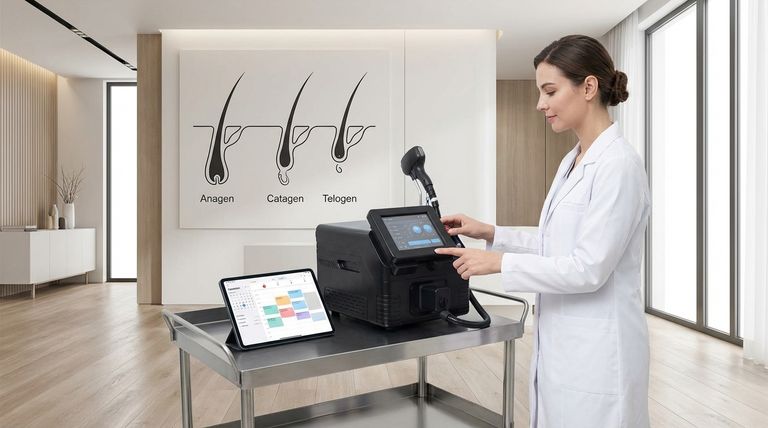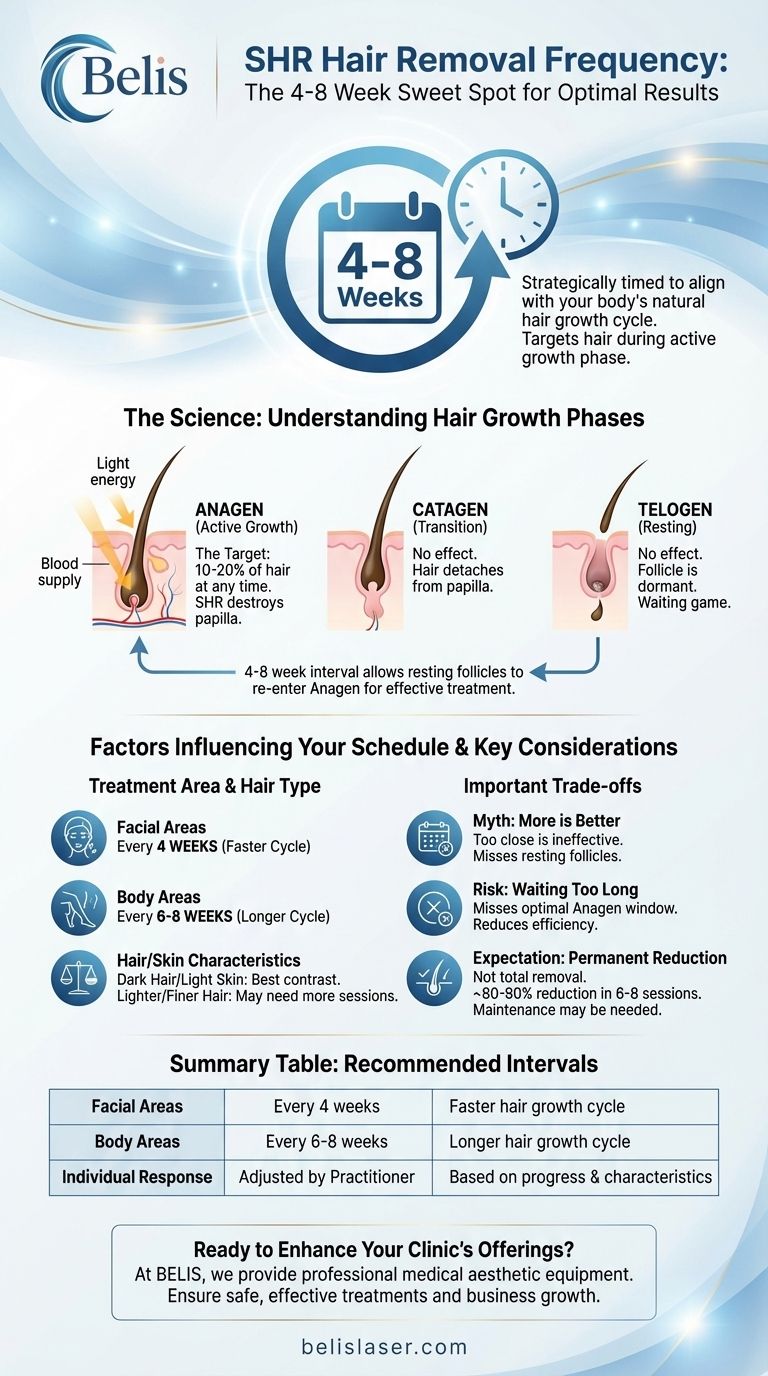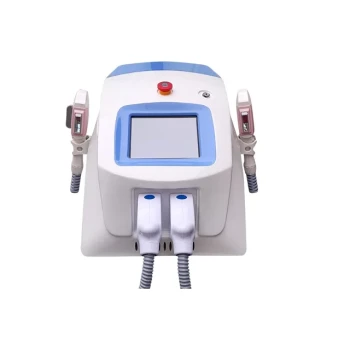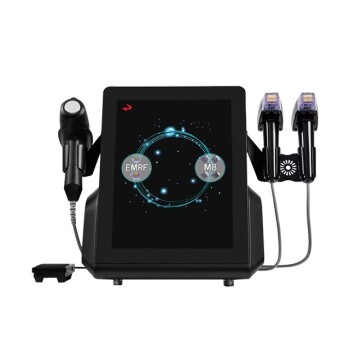For optimal results, SHR hair removal sessions are typically scheduled every 4 to 8 weeks. This interval is not arbitrary; it is strategically designed to align with your body's natural hair growth cycle. Successful treatment depends entirely on targeting hair during its active growth phase, and this schedule maximizes the chances of doing so over time.
SHR treatment frequency is a strategic plan to target hair during its active growth (anagen) phase. Since only a fraction of your hair is in this phase at any one time, multiple sessions spaced weeks apart are necessary to effectively disable the follicles as they cycle into the correct stage.

The Science Behind the Schedule: Understanding Hair Growth
To understand the treatment interval, you must first understand how hair grows. Hair follicles cycle through three distinct phases, and SHR is only effective during one of them.
The Anagen Phase (The Target)
This is the active growth phase. During this time, the hair is attached to the papilla (the base of the follicle), which supplies it with blood.
SHR technology uses light energy, which is absorbed by the melanin in the hair and converted to heat. This heat travels down the hair shaft to destroy the papilla, preventing future growth. This can only happen when the hair is actively connected to its root.
The Catagen & Telogen Phases (The Waiting Game)
The catagen phase is a short, transitional stage where the hair detaches from the papilla. The telogen phase is the resting stage, where the old hair falls out and the follicle remains dormant for a period before a new anagen hair begins to form.
If a hair is in the catagen or telogen phase during treatment, the heat cannot reach and destroy the papilla. This is why a single session can never remove all hair.
Why 4-8 Weeks is the Sweet Spot
At any given moment, only about 10-20% of your body's hair is in the anagen phase. The 4 to 8-week interval is designed to give the resting follicles time to re-enter the anagen phase so they can be effectively targeted in your next session.
The exact timing within this range depends on the treatment area, as different parts of the body have different growth cycle lengths.
Factors That Influence Your Personal Treatment Plan
While 4-8 weeks is the standard, your practitioner will create a personalized schedule based on several key factors.
Treatment Area
Hair on the face has a much shorter and faster growth cycle. For this reason, facial hair treatments are typically scheduled closer together, often every 4 weeks.
Body areas like the legs, back, and arms have longer growth cycles. Treatments for these areas are usually spaced further apart, typically every 6 to 8 weeks.
Hair and Skin Characteristics
SHR works best when there is a strong contrast between dark hair and lighter skin. The melanin in dark hair acts as the primary target for the light energy.
Individuals with lighter, finer hair may find they need more total sessions (often more than the standard 6-8) to achieve their desired reduction, as the hair contains less of a target for the energy.
Individual Response
Hormones, genetics, and age can all influence the rate and nature of your hair growth. A skilled technician will assess your progress after each session and may adjust the timing slightly to optimize results.
Understanding the Key Trade-offs
Sticking to the recommended schedule is crucial for success. Deviating from it can compromise your results and lead to wasted time and money.
The Myth of "More is Better"
Scheduling sessions too close together (e.g., every two weeks) is ineffective. You are simply retreating the same follicles that were already in the anagen phase while completely missing the ones that are still in the resting phase. This will not speed up the overall process.
The Risk of Waiting Too Long
Conversely, extending the time between sessions beyond the recommended window (e.g., waiting 10-12 weeks) is also counterproductive. This creates a risk of missing the optimal anagen phase window for a large group of follicles. This reduces the efficiency of each session and will likely result in needing more total treatments to achieve your goal.
Permanent Reduction, Not Total Removal
It is important to view SHR as a method for permanent hair reduction, not total removal. After a full course of 6-8 sessions, you can expect a very significant (e.g., 80-90%) reduction in hair. However, hormonal changes or dormant follicles can sometimes produce new, fine hairs over time, which may require a maintenance session once or twice a year.
Finalizing Your SHR Schedule
Your practitioner is your best resource, but understanding the principles empowers you to be an active participant in your treatment plan.
- If you are treating facial areas: Expect to schedule sessions closer to the 4-week mark to match the faster hair growth cycles.
- If you are treating body areas (like legs or back): Plan for sessions spaced 6 to 8 weeks apart to align with the longer growth cycles.
- If you have lighter or finer hair: Be prepared for a potentially longer treatment course and adhere strictly to the schedule to maximize the effect of each session.
- If you are planning for long-term maintenance: After completing your initial course, plan for a possible touch-up session once or twice a year to manage any new growth.
Consistency and patience are your greatest allies in achieving a successful, long-term reduction in unwanted hair.
Summary Table:
| Factor | Recommended Interval | Key Consideration |
|---|---|---|
| Facial Areas | Every 4 weeks | Faster hair growth cycle |
| Body Areas (Legs, Back) | Every 6-8 weeks | Longer hair growth cycle |
| Individual Response | Adjusted by practitioner | Based on hair/skin type and progress |
Ready to start your personalized SHR hair removal plan?
At BELIS, we specialize in providing professional medical aesthetic equipment to clinics and premium beauty salons. Our advanced SHR technology ensures safe, effective, and comfortable treatments for your clients, leading to higher satisfaction and business growth.
Let us help you enhance your service offerings. Contact our experts today for a consultation on the best equipment for your needs.
Visual Guide

Related Products
- Diode Laser SHR Trilaser Hair Removal Machine for Clinic Use
- Clinic Diode Laser Hair Removal Machine with SHR and Trilaser Technology
- Trilaser Diode Hair Removal Machine for Beauty Clinic Use
- Diode Tri Laser Hair Removal Machine for Clinic Use
- IPL SHR Hair Removal Machine for Permanent Hair Removal
People Also Ask
- What skin type is diode laser for? Safe Hair Removal for Light to Dark Skin
- Can diode laser permanently remove hair? Achieve Lasting Hair Reduction with Professional Treatment
- Can diode laser remove hair permanently? Achieve Long-Term Hair Reduction with Precision Technology
- Does diode laser remove hair permanently? Understanding Permanent Hair Reduction
- What is the most effective form of laser hair removal? Find the Perfect Laser for Your Skin & Hair



















